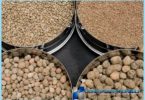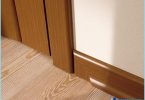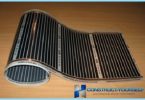The linoleum for a long time occupies a leading position when choosing flooring. A wide range of technical characteristics allows to use it in an office and living quarters with different conditions of external influence. After examining the features of certain types of linoleum, a consumer with skill will make the selection of the option most appropriate to the available conditions.
The variety of linoleum ↑
Linoleum is classified according to various criteria. The parameters that mainly focuses on the buyer – the degree of load, structure, properties.
Depending on the designated purpose, the linoleum is:
- Commercial. Has a high wear resistance. The main places of operation are hospitals, kindergartens, offices, hotels and shopping facilities.
- Household. Characterized by lower strength is used in areas with little traffic, performs the function of flooring exclusively in residential apartments or houses.
- Semi-commercial. It is the middle link between the two previous types. With durability at a decent level, unlike the domestic version, at the same time less demanding in terms of installation than the commercial type. The optimal environment of use – the places with medium traffic.
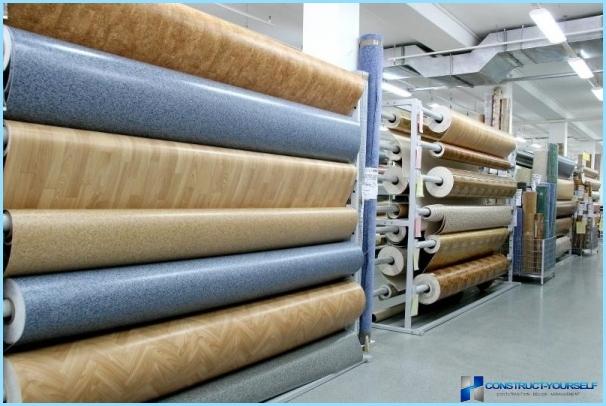
Semi-commercial linoleum has a different structure. The most common version is a heterogeneous material, rarely homogeneous and cork. Technical characteristics of semi-commercial linoleum does not include the ability to accumulate static electricity, there is heat-insulated and fireproof flooring options.
Fire semi-commercial linoleum is designed for use in places where fire safety has high demands. Most often this is a room with a large crowd of people. The degree of combustibility of the material there are the following groups:
- poorly flammable (G1);
- moderately flammable (G2);
- normally flammable (G3);
- highly flammable (G4).
Linoleum marked G1 relates to non-flammable and are required to apply on evacuation routes.
Description heterogeneous coverage ↑
Heterogeneous linoleum – improved product for floor surface that is suitable for various bases and with a wide range of applications. Strength – the distinguishing feature of heterogeneous commercial linoleum. Whereby it is achieved?
The composition of the material ↑
The secret lies in the presence of a polyurethane layer, providing the resistance of products to aggressive. In the context of the structure of semi-commercial linoleum contains the following layers:
- PVC. On it rests the main protective function. This element provides the desired strength, in some cases, it is further coated with polyurethane or polyacrylic. Manufacturers at their discretion determine the optimal layer of PVC, when selecting a product for this feature should pay particular attention, as the extra thickness increases the lifetime of heterogeneous commercial linoleum.
- The figure covers the layer of PVC. In the presence of six variants of colors. For imaging, use special printing cylinders. Possible variants of smooth and textured pattern. The last option is achieved by adding into the paint inhibitors.
- Canvas of PVC. Besides giving semi-commercial linoleum strength, its tasks include the formation of sound and thermal insulation properties.
- Fiberglass plays the role of the frame in the overall structure. The other components are attached to it. Taking care of the product quality, it is necessary to clarify the density and strength of fiberglass. The optimal parameters correspond to 55 g/sq. m. and 30 g/sq m.
- As the substrate are different materials. In most versions present foamed PVC, less common felt or jute.
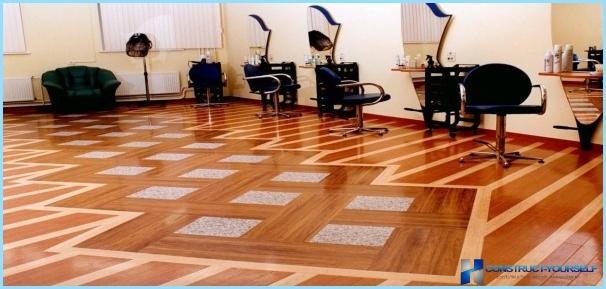
Specifications ↑
Semi-commercial heterogeneous linoleum has the following specifications:
- weight of 1 sq. m. products ranges from 2.0 to 2.5 kg, the domestic counterpart these figures are equal to 1,2-1,8 kg;
- the width of the produced material has a range from 2.0 to 4.0 m;
- a thick protective layer can withstand high temperature and resistant to mechanical damage;
- a layer of glass fiber increases the wear resistance;
- the minimum guarantee on a semi-commercial product for 7 years, the upper limit of maintenance is 20 years.
In addition to the traditional technical performance, semi-commercial heterogeneous linoleum confer additional properties, increasing its operational ability. Among the individual models is found enhanced colour-fastness, presence of antibacterial protection, suitability for use with Underfloor heating. Depending on the intended purpose of the room, semi-commercial linoleum has a gradation of classes:
- class 32 – for use in offices with low permeability;
- class 33 – used in areas with an average load;
- class 34 – sufficiently resistant to impacts in areas with high load.
Fluctuations in the value of the product depend on the level of hardness of the lower layer, the porous coating is cheaper more flexible analogue. Leaders in the production of semi-commercial linoleum are considered to be companies from Italy and Germany. An acceptable combination of cost and quality characteristics present from Russian producers and companies from Eastern Europe.
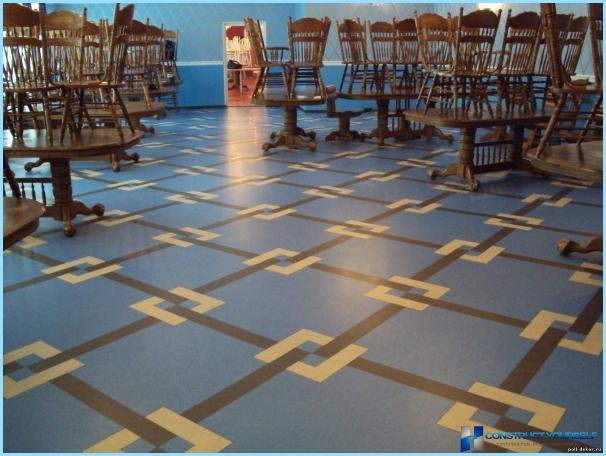
The advantages of semi-commercial coating: ↑
- resistance to impact and abrasion;
- ease of installation and ease of use;
- resistant to moisture and chemical compounds.
- affordable pricing policy, combined with a long period of operation;
- the variety of images will allow you to pick the pattern for any decorative design of the premises;
- the relief surface has anti-slip properties.
The main disadvantage of semi-commercial linoleum is to use synthetic materials in the production.
Features of homogeneous species ↑
The homogeneous structure regardless of the thickness of the product is the leading difference homogeneous heterogeneous linoleum. Consisting of polyvinyl chloride, its composition is supplemented by the accompanying components: plasticizers, dolomite, chalk, lime, quartz sand and pigments. Pattern homogeneous linoleum penetrates the entire thickness of the product. This feature allows you to save the picture almost in its original form at any stage of wear of semi-commercial material. The pattern can be oriented or positioned randomly. The latest version is much easier – contamination coating is not evident. However, the choice of colors is quite meager and is limited to a solid surface or a reproduction of natural materials (marble, etc.).
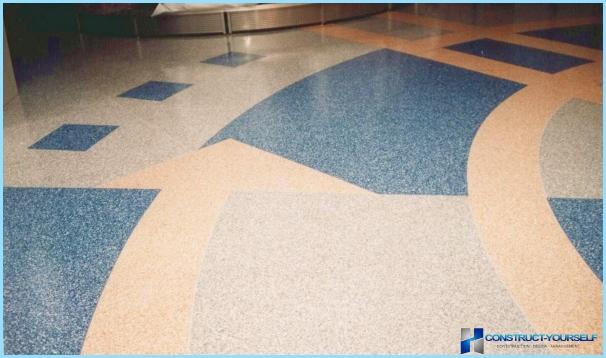
Technical characteristics of homogeneous linoleum have the following indicators:
- layer thickness: 1,5-2,0 mm – thin, 2.0 to 3.0 mm thick;
- durability: class 33-34 – office space with a high degree of training, 41-43 class – commercial premises with low, medium and high load, respectively.
There are tests to determine the abrasion, the essence is the impact on the surface of the abrasive wheel subsequent measurements in a loss of thickness. Homogeneous products presented in the following categories:
| Marking | Level of strength | Loss, mm | The content of impurities, % |
| F | The lowest | Not more than 0.6 mm | About 65 |
| M | Low | 0,15-3,0 | 40-65 |
| P | Average | 0,08-0,15 | About 40 |
| T | High | Not more than 0.08 | Minimum |
The lightning bolt indicates a static defense. His absence says about the ability of commercial products to accumulate electric current. In areas with large flow of people, the exploitation of unprotected linoleum inappropriate. The picture of the sun on the packaging indicates the consistency. Not finding the specified character cover better lay in areas not exposed to sunlight. Otherwise semi-commercial homogeneous linoleum will quickly lose the original color.
The purpose of anti-static linoleum ↑
In rooms with working appliances regularly observed accumulation of static charge. It can disrupt the action of electrical equipment. To ensure smooth and accurate operation of the measuring equipment should exclude accumulation of static electricity. The most acceptable solution to the problem is the elimination through the floor with special antistatic linoleum.
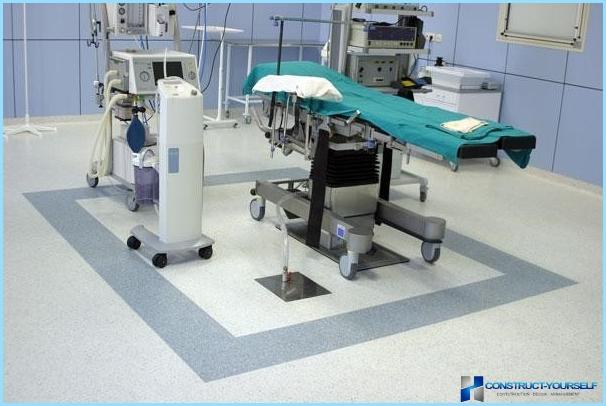
Main technical specifications anti-static commercial linoleum the following:
- Introduced in the special plasticizers reduce the resistance of anti-static products to 109 Ohms. Formed on the surface when walking charge evenly dispersed across the surface of the coating.
- The lack of interdependence between the humidity and electric resistance allows to use it in all types of premises.
- Meet all the requirements of strength and wear resistance, as any breach of the coating lead to nonuniform distribution of electric charge.
- When installing linoleum antistatic high requirements given the quality of the base.
- Elasticity and insulation products at a high level.
- Coating is heat resistant, difficult to ignite, friction heating is not observed.
- Antistatic semi-commercial linoleum is not subject to fading when exposed to sunlight.
Considering the main purpose of the product in terms of electrical safety, periodically the material that is tested for compliance with required parameters.
Having information about the planned operation conditions and technical characteristics of the material, to select the appropriate semi-commercial linoleum does not pose serious difficulties.

